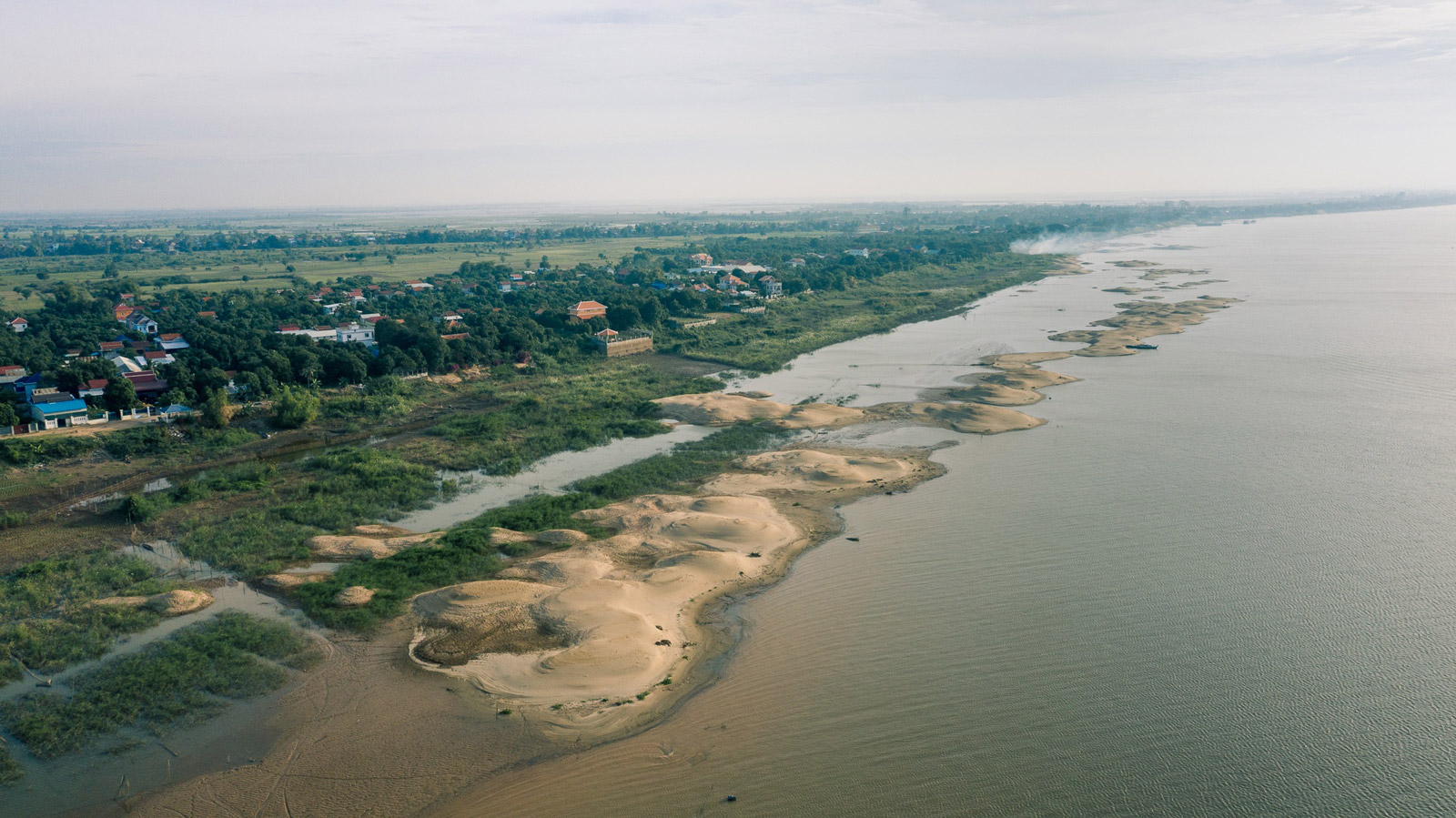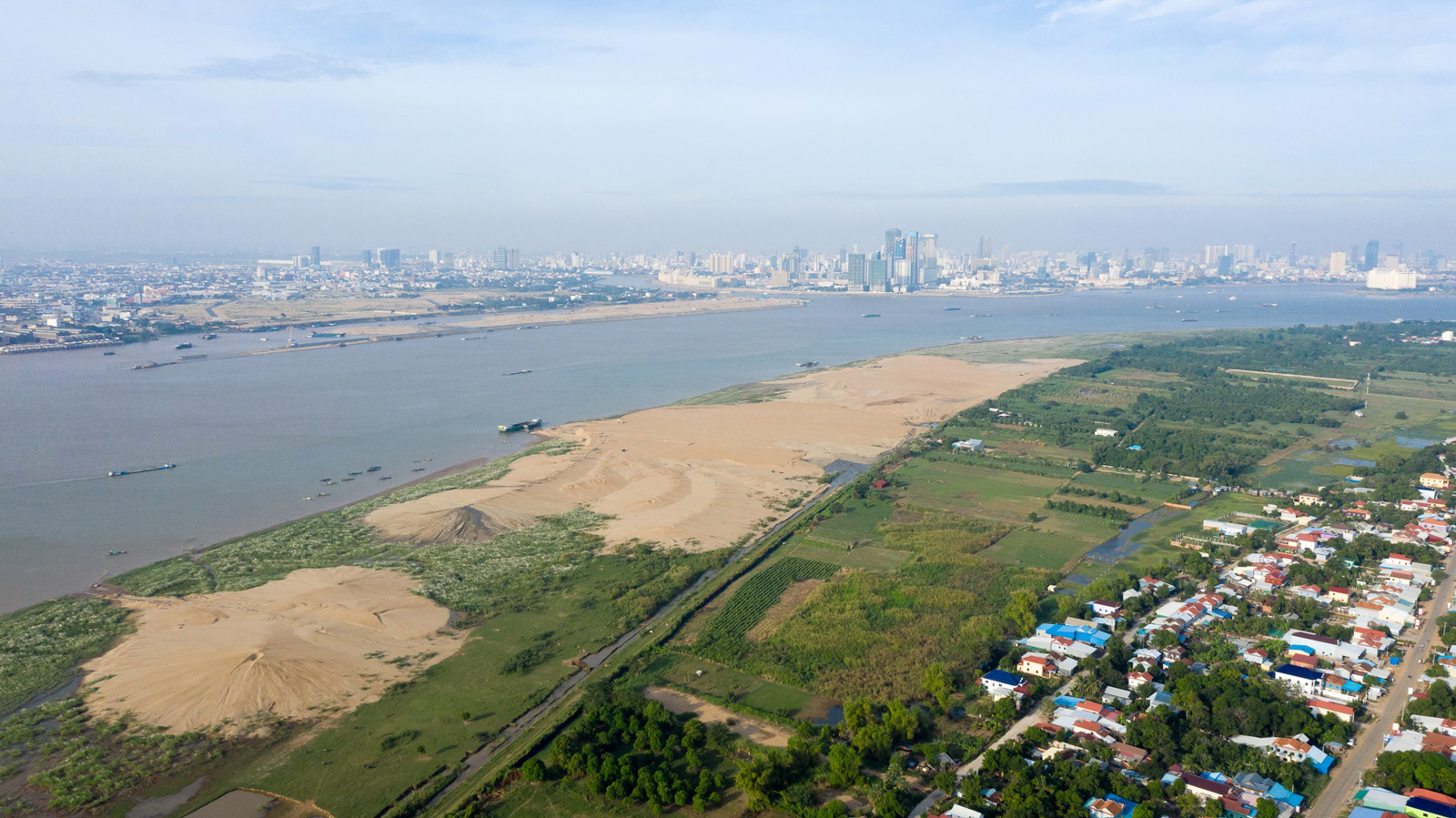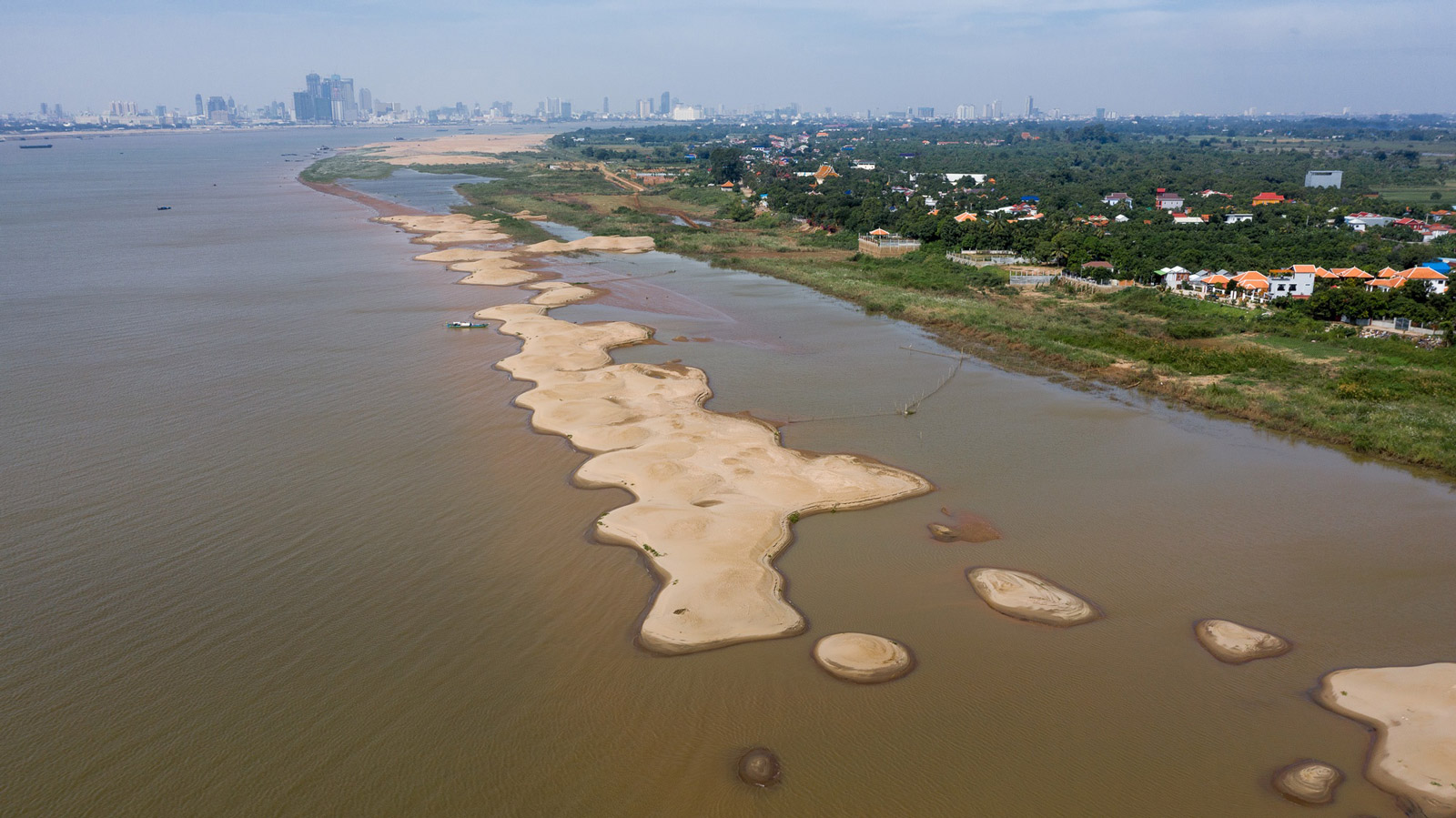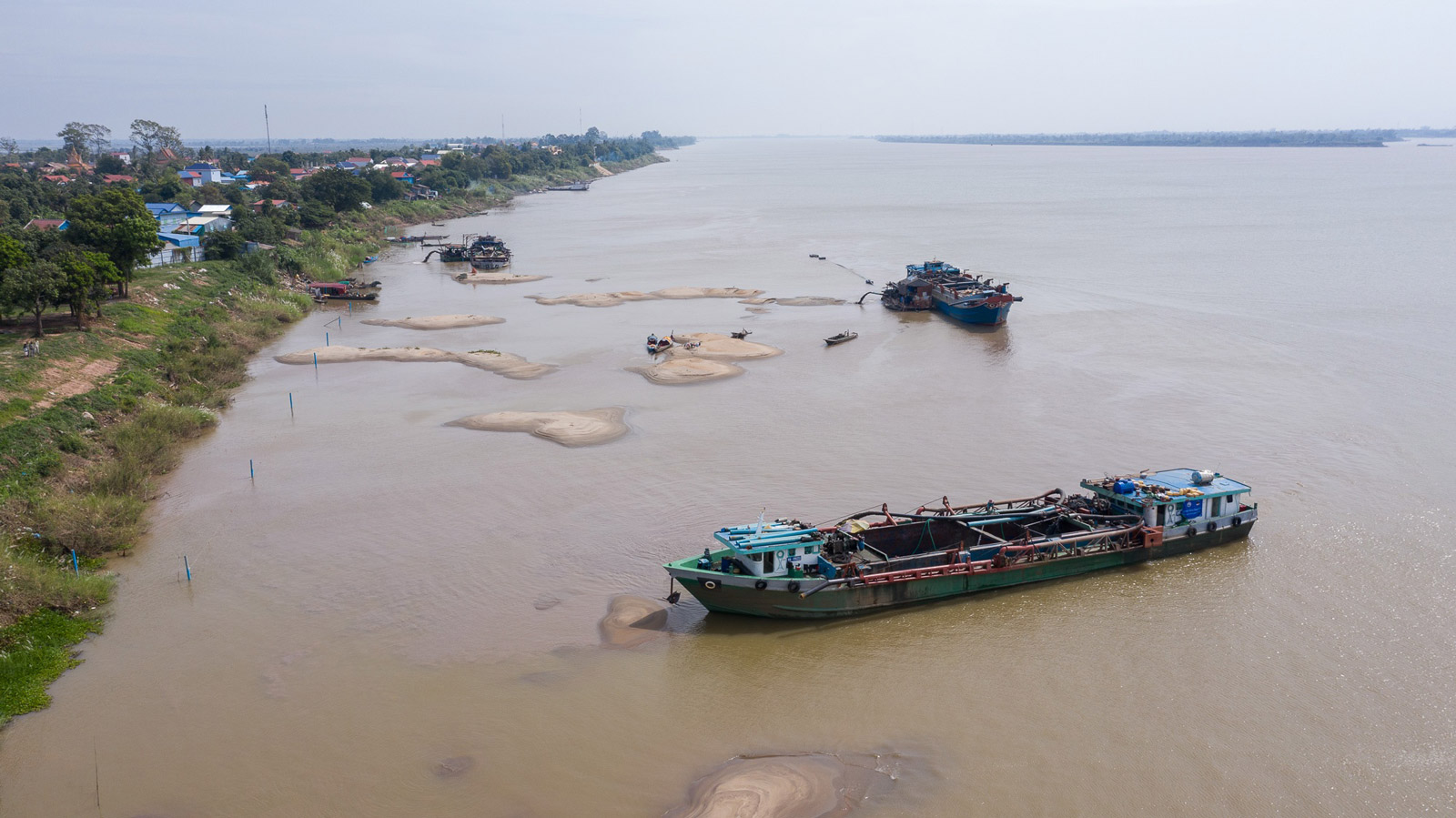In Cambodia, this village shows even the wealthy are vulnerable to land grabbing
While high-profile land grabbing disputes involving disempowered communities have made headlines in Cambodia in recent years, the case of Arey Ksat – a village of well-connected and wealthy residents near Phnom Penh – shows few are safe from the practice

Additional reporting from Yon Sineat. All images by Enric Català Contreras
The river view behind the house was broad and serene, a wide expanse of the Mekong flowing just past the newly occupied villa.
A pretty sight, and prime real estate too. So when the sand pumping crews showed up just after the housewarming party late last summer, manning their hoses alongside roaring diesel engines to pour a seemingly endless slurry beginning at about dawn each day, the homeowner was reasonably upset. They’d gone through the trouble of making a home on the riverbank only to find the riverbank being made almost up to the home itself.
“Every morning, you can just hear them fucking up your land,” the homeowner said, asking to go unnamed.
Filling in the Mekong has been big business over the past year, with major developers dredging and pouring sand with little to no public scrutiny. Now, a new embankment is taking shape just across the river from Phnom Penh, apparently without any legal concession, busily filling in the riverside and hemming in a group of landowners who say they’re legally entitled to access the river – a line now being closed by a growing heap of sand.
Some well-to-do residents on the banks today paid top dollar for the property along the water’s edge. But, buyer beware, their once-quiet homes have now become a case study on the nature of land ownership and development in Cambodia, where it’s not uncommon for landowners, sometimes with limited legal claims to their property, to face off against large developers and well-connected tycoons.
The case unfolding now near Arey Ksat village is unusual in that several of the residents have ample financial resources and, within one group of households, include a fairly well-connected bunch. Their ranks include at least one developer, a noted philanthropist and an honorary Spanish consul, one of a few scattered in Asian countries where Spain lacks an official diplomatic mission. The land deals of these residents, while not backed with the Cambodian gold-standard of a hard title, were vetted with an eye to protecting a long-term investment on the riverside.
“They started this literally when I just moved in,” said one business person who asked to go unnamed. “They’ve not told us anything. Just a lot of the government officials who have said what they’ve heard, but they’ve not shown us any paperwork, because there’s nothing to show and they’re too afraid to say they don’t have it.”

Still, even those with money and business savvy aren’t immune to the displacing power of development in Cambodia, where even the Mekong itself is open for new construction.
The developer at the heart of the story, Khun Sea, is a land man whose self-titled firm enjoys connections with some of Cambodia’s most powerful people. The Khun Sear Import Export company received a land concession in 2019 from the national government’s top executive body, the Council of Ministers, to build a satellite city on a 70 hectare plot of land in Arey Ksat village, across the river from Phnom Penh on the east bank of the Mekong.
That much was legally approved and was widely seen as a step towards capitalising on surging realtor interest in the area, which today is still a land of mango orchards and quiet dirt roads just a short ferry ride from downtown Phnom Penh. Land prices near the village have risen dramatically in recent years, with riverside plots fetching about $1,000 per square metre ahead of buzz of eventual bridge construction to join the area more easily to the city.
While chatting with the Globe’s reporter, he also spoke at length with a resident who approached him to complain about the sand blocking her access to the river, insisting that the company was within its rights to fill in the water
But with such valuable land in short supply, sand-pumping boats connected to the Khun Sear company have, since about September last year, pushed well beyond the bounds of their concession. Grain by grain, the developer is building a seemingly unlicensed embankment a little more than two kilometres long, now sealing in the old riverfront, claiming state-owned land and encroaching on the frontage of the homeowners.
According to a company representative posted along the river to oversee the sand filling, the new bank will eventually reach at least 150 metres into the waterway, though recent pumping operations appeared to extend even farther out.
A search of a state database of public records conducted by an attorney at the request of the Globe found no sign the additional filling was permitted by an official concession. Calls to a line identified as belonging to Mr Khun Sea went unanswered. The number listed for his company in the Ministry of Commerce registry was disconnected when a reporter called, and the firm appears not to have a website nor social media.
While the head man was unreachable, the Khun Sear representative told Globe reporters his firm had all necessary permissions to begin filling in the stretch of river, though he added that he didn’t know which exactly those were, nor where any documentation of such could be found.
The representative said future development on the new strip of land might one day include condos and individual homes, as well as a strip of green space – a vanishing rarity in Phnom Penh. While chatting with the Globe’s reporter, he also spoke at length with a resident who approached him to complain about the sand blocking her access to the river, insisting that the company was within its rights to fill in the water.
Neth Pheaktra, spokesperson for the Ministry of Environment, said his office had no information about the filling project. Phay Siphan, spokesperson for the Council of Ministers, did not respond to a request for comment.
The Mekong itself is officially state-owned in Cambodia, as is the stretch of silty riverbed regularly exposed when the dry season causes water levels to fall. That temporary land falls within the public domain, and the rich soils are typically used for vegetable gardens by neighbouring landowners and villagers who live further inland.
Noun Phymean is a landowner on the banks who heads a non-governmental organisation called the People Improvement Organization, a group that provides food and education to vulnerable children. She said access to the river and the fertile lands along its edge was supposed to be protected in her land title.
Now, she fears the lack of transparency in the sand filling is a sign that further encroachment might soon follow. For those with expensive riverfront property, this could most likely happen through a national land stipulation that holds a 50-metre setback from waterways to be state-owned, with only possession rights for residents. Rules like this may be benign in quiet times and on unnoticed plots of land, but the residents on the banks near Arey Ksat are now fearing a possible land grab.
“We’re supposed to have the right to use that land in front of us,” Phymean said. “I don’t want to say we’re fighting, but we want our rights.”

As with other Cambodian tycoons, Khun Sea has seemingly benefited over the years from having friends in high places. He counts a very well-connected business partner in Yim Leang, the vice president of the cabinet of the Cambodian People’s Party Central Committee and a leader of the National Police.
On the familial side of things, Yim Leang is the son of Yim Chhay Ly, a Cambodian deputy prime minister, and is a brother-in-law to Hun Many, the youngest son of Prime Minister Hun Sen. Yim Leang’s wife is also the daughter of the Cambodian Minister of Land Management Chea Sophara.
Leang, who reportedly owns a 10% stake of the developer’s company, has regularly appeared over the years in media coverage of Khun Sea’s business dealings. In one instance, that meant speaking up on his partner’s behalf after the tycoon built a gate across part of Hun Sen Boulevard under the rationale that a road expansion had crossed into his land.
“I want to ask you: If someone asked to cut your newspaper’s land, would you agree?” Leang told a reporter from the now-defunct Cambodia Daily.
Land has been plentiful for the Khun Sear company, which in 2012 received an 8,200 hectare agricultural concession in the Kulen Promtep Wildlife Sanctuary of Oddar Meanchey province. Other, more urban acquisitions came with more effort.
The company gained notoriety after 2007 as it fell into a yearslong dispute with a group of families in Phnom Penh’s Toul Kork district. According to claims supported by various Cambodian human rights groups, men hired by the firm physically intimidated and attacked a group of families in a bid to get them to sell their land, at one point in 2013 even allegedly throwing cobras into the home of some of the holdouts.
Police would later arrest members of the last family to resist selling, detaining them on charges of fighting with the men the family said were hired to drive them out. Once the family members were released from prison, they sold their land for a reported sum of $180,000.
With that history fresh in everyone’s mind, the residents now living near Arey Ksat are wary of going directly against the developer. Those who spoke with the Globe preferred to do so under anonymity, lest they make themselves a target for retribution.
Even still, Naly Pilorge, director of Cambodian human rights group LICADHO, was well familiar with the company. Pointing back to the intimidation campaign of Toul Kork, she told the Globe it was understandable the residents along the banks of the Mekong would be afraid of too loudly asserting their rights.
“To this day the company has been given impunity. This is a cause for concern in any dispute involving [it],” Naly said in a message. “We are worried that families who might want to seek legal remedies will not be given a fair and impartial court process.”

As new towers rise over Cambodia, some of the biggest construction projects are happening right underfoot. Developers large and small have leapt at the chance to build new land where water once flowed, lapped and trickled across the country – from Ream Bay on the southern coast of the Gulf of Thailand to the Cheung Ek wetlands south of Phnom Penh.
The filling of the mighty Mekong has also accelerated this year on the back of an estimated $2.5 billion being invested in the 125-hectare-plus Koh Norea project now taking shape just south of its predecessor, the artificially expanded Koh Pich, at the junction of the Bassac and Mekong rivers.
The environmental toll of all the filling on the river is little studied, at least in a publically accessible way, and the inland sand mining industry as a whole is a poorly understood affair.
Representatives from the national Ministry of Mines and Energy told the Globe late last year that Cambodian dredgers in 2019 extracted 9 million cubic metres of river sand to pump into the booming construction sector. Not long after, Cambodia’s largest construction association wrote that OCIC alone would require about 90 million cubic metres of sand to complete just two of its current projects. Of that, 60 million metres would fill its Koh Norea development, with the rest going into reclamation for a new $1.5 billion airport being constructed south of Phnom Penh.
They might be able to take our right to the river from us, but we won’t give it to them willingly. We have full trust that the courts of Cambodia and Prime Minister Samdech Techo Hun Sen will protect our foreign investment
Though fishermen still ply the waters near Arey Ksat, today an observer is just as likely to see the children of anglers playing or hanging up clothes to dry on the new sand dunes where their parents once hauled nets.
Up on firmer land, residents on the riverbank say the speed at which sand has replaced water has been cause for alarm.
Javier Solá, a computer scientist and long-time resident of Cambodia, serves as an honorary consul to Spain. When representatives of the Khun Sear company came with police to put down cement posts claiming ownership of a wide space between the river and the family home, the Solás began moving forward with a legal defence. They’ve now advanced a complaint to the Kandal Provincial Court to fight for access to the sediment and the river, both of which they say should be protected as part of their land title atop the bank.
“They might be able to take our right to the river from us, but we won’t give it to them willingly,” Javier Solá said. “We have full trust that the courts of Cambodia and Prime Minister Samdech Techo Hun Sen will protect our foreign investment.”
Throughout this case on the disputed riverside at Arey Ksat run the traces of perilous land ownership in which hard titles, the strongest certification of Cambodian land rights, can be difficult to come by.
Matt Rendall, an attorney with SokSiphana & Associates law firm in Phnom Penh, helped draft the 2001 Land Law that officially provided a structure for outright ownership of land in Cambodia. He said the hard title certificate confirms a parcel of land being officially registered to a person or entity with the Ministry of Land Management.
“If you are on the title, that is what’s made you the owner – the very fact you’re on the registry has done it,” Rendall said.
But these titles aren’t yet available everywhere in the country, leaving many residents, even those of means, to rely on ‘soft titles’ – records of land ownership drafted between buyers and sellers, typically recognised by local government bodies. These confer rights but aren’t recognised nationally and may be overruled in a dispute, leaving their holders more vulnerable to losing land in a conflict.
Naly of LICADHO said the lack of comprehensive titling across the country put landowners of all kinds at risk.
“Obtaining hard titles is impeded by corruption and bureaucracy. And legal provisions set in the 2001 Land Law that give a pathway to ownership through occupation can be arbitrarily ignored in areas where powerful tycoons have vested interests,” Naly said.
She added that the transfer of land ownership from public to private actors, as might very well happen eventually with the new riverbank, can be facilitated with the right friends.
“In recent years, well-connected figures have been able to gain land through state ‘giveaways’, where the government donates large areas of land to those individuals in exchange for nothing,” Naly said.
One resident along the Mekong riverbanks, the business person who asked to go unnamed, said they’d paid for the Ministry of Land Management to come and GPS map their plot, a practice that typically confers hard titles. The resident is still waiting for that to happen and, in the meantime, is worried the Khun Sear company might be empowered to encroach even further onto their land.
Just months after completing construction of a new home, they’re at wit’s end.
“It’s incredibly frustrating,” the business person said. “The psychological part of it too, that has been difficult. You feel powerless.”

